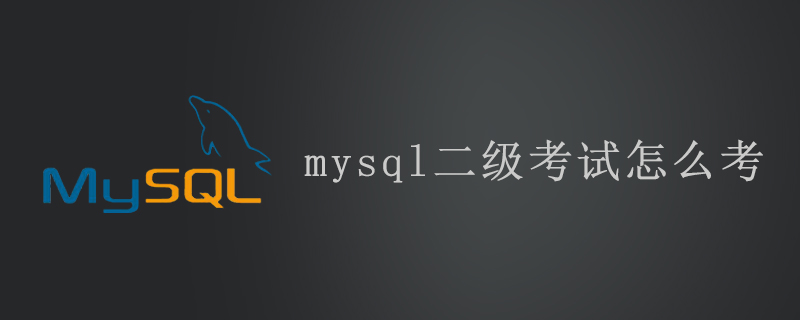Home >Database >Mysql Tutorial >How to take the mysql level 2 exam
How to take the mysql level 2 exam
- little bottleOriginal
- 2019-05-29 14:46:574835browse
Mysql Computer Level 2 exam is a computer-based exam, and the exam content is the basic knowledge of MySQL. Let’s learn more about it together.

Question types and points
Single-choice questions 40 points (including 10 points for the common basic knowledge part)
Operation questions 60 points (including basic operation questions, Simple application questions and comprehensive application questions)
Examination environment
Development environment: WAMP 5.0 and above
Database management system: MySQL 5.5
Programming language: PHP
Exam outline As follows:
1. Basic concepts and methods
1. Basic knowledge of database
(1) Basic concepts related to database
(2) Characteristics and structure of database system
(3) Data model
2. Relational database, relational model
3.Basic of database design
(1) Steps of database design
(2) Methods of relational database design
4. MySQL overview
(1)MySQL system features and working methods
(2) MySQL programming basics (Structured Query Language SQL, MySQL language structure)
2. SQL interactive operations under the MySQL platform
1. Database
(1) Basic concepts and functions of MySQL database objects
(2) Operation methods and applications of using SQL statements to create, select, modify, delete, and view MySQL database objects
2. Data table (or table)
(1) Basic concepts and functions of data table (or table), table structure, and table data in MySQL database
(2) Using SQL Statement creation, update, rename, copy, delete, view data table operation methods and applications
(3) Use SQL statements to implement table data insertion, deletion, update and other operation methods and applications
(4) Use SQL statements to implement simple queries, aggregation queries, join queries, conditional queries, nested queries, and joint queries on one or more data tables. Operation methods and applications
(5) Basic concepts, classification and functions of data integrity constraints
(6) Operation methods and applications of using SQL statements to define, name, and update integrity constraints
3. Index
(1) Basic concepts, functions, storage and classification of indexes
(2) Operation methods, principles and applications of using SQL statements to create, view and delete indexes
4. View
(1) Basic concepts, characteristics and usage principles of views
(2) The difference between views and data tables
(3) How to create and delete views using SQL statements and application
(4) How to use SQL statements to modify and view view definitions and their applications
(5) How to use SQL statements to update and query view data and their applications
3. MySQL database programming
1. Triggers
(1) Basic concepts and functions of triggers
(2)Usage The operation method and application of SQL statements to create and delete triggers
(3) Types and differences of triggers
(4) The use and principles of triggers
2. Event
(1) Basic concepts and functions of events and event schedulers
(2) Operation methods and applications of using SQL statements to create, modify, and delete events
3 , Stored procedures and stored functions
(1) The basic concepts, characteristics and functions of stored procedures and stored functions
(2) The difference between stored procedures and stored functions
( 3) Basic concepts and construction methods of stored procedure bodies
(4) Operation methods and applications of using SQL statements to create, modify, and delete stored procedures
(5) Calling methods of stored procedures
(6) Operation methods and applications of using SQL statements to create, modify, and delete stored functions
(7) How to call stored functions
4. MySQL Management and maintenance
1. Use and management of MySQL database server
(1) Basic methods of installing and configuring MySQL database server
(2) Starting, Basic method to shut down the MySQL database server
(3) MySQL database server client management tool
2. User account management
(1) MySQL database user account management Basic concepts and functions
(2) Operation methods and applications of using SQL statements to create, modify, and delete MySQL database user accounts
3. Account permission management
(1) The basic concepts and functions of MySQL database account permission management
(2) Operation methods and applications of using SQL statements to grant, transfer, restrict, and revoke MySQL database account permissions
4. Backup and recovery
(1) Basic concepts and functions of database backup and recovery
(2) How to use MySQL database backup and recovery
(3) Basic concepts and functions of binary log files Function
(4) How to use binary log files
5. MySQL application programming
1. Basic usage of PHP language
(1) Features and programming foundation of PHP language
(2) Basic steps and methods of using PHP language for MySQL database application programming
2. The programming under MySQL platform is based on B / S structure PHP simple application
(1) Understand the process of compiling a simple PHP application based on B / S structure under the MySQL platform
(2) Master the related technologies and methods of database application programming under the MySQL platform in the process of compiling PHP simple applications
The above is the detailed content of How to take the mysql level 2 exam. For more information, please follow other related articles on the PHP Chinese website!

